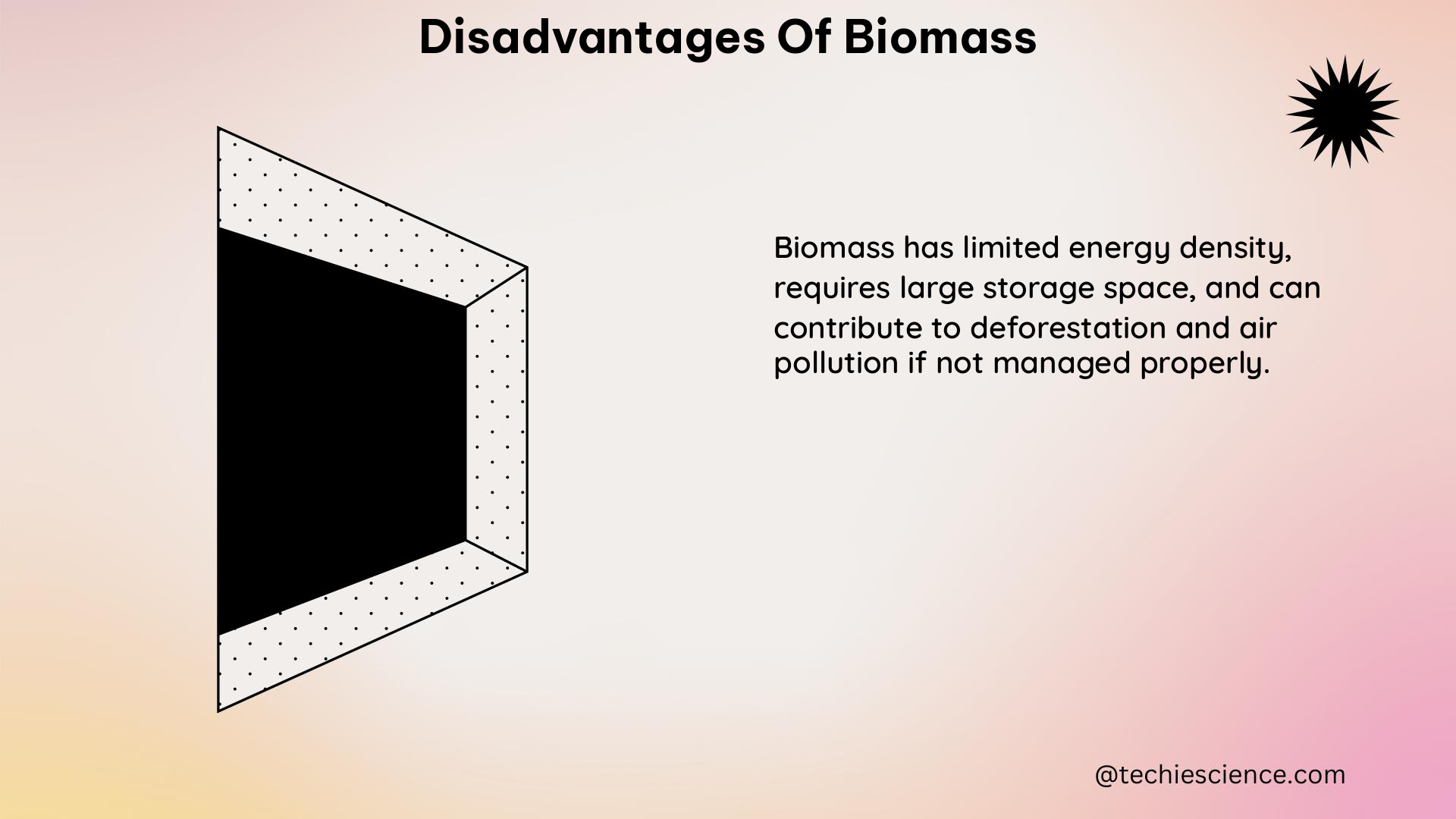Biomass energy, while touted as a renewable and sustainable energy source, comes with significant drawbacks that must be carefully considered. From high costs and land requirements to greenhouse gas emissions and environmental impacts, the disadvantages of biomass energy are multifaceted and far-reaching. This comprehensive guide delves into the technical details and specific data points that shed light on the challenges associated with biomass energy production.
High Costs of Biomass Energy Production
The production of biomass energy can be an expensive endeavor, with several cost factors to consider:
-
Upfront Investment: Constructing a biomass energy plant requires a significant upfront investment, with costs ranging from $2,000 to $5,000 per kilowatt of installed capacity. This can be a significant barrier to entry, especially for smaller-scale projects.
-
Feedstock Acquisition: The cost of acquiring and transporting biomass feedstock, such as agricultural residues, energy crops, or municipal solid waste, can be substantial. According to a study published in the Journal of Cleaner Production, the feedstock cost can account for up to 50% of the total operating costs of a biomass power plant.
-
Conversion Efficiency: The conversion efficiency of biomass to energy is generally lower than other renewable energy sources, such as solar or wind. This means that more biomass material is required to generate the same amount of energy, further increasing the overall costs.
-
Maintenance and Operation: Biomass energy plants require regular maintenance and operation, which can add to the ongoing costs. This includes the upkeep of the plant’s machinery, as well as the labor required to manage the facility.
To illustrate the financial impact, consider the following example: A 20 MW biomass power plant with a capital cost of $4,000 per kilowatt would require an initial investment of $80 million. Additionally, the annual operating and maintenance costs for such a plant can range from $3 million to $5 million, according to a report by the National Renewable Energy Laboratory.
Significant Land Requirements

Biomass energy production requires a significant amount of land, both for the cultivation of energy crops and the siting of biomass energy plants. This can lead to several challenges:
-
Land Use Competition: The land required for biomass energy production can compete with other land uses, such as food production, forestry, or natural habitats. This can create tensions and tradeoffs between energy and other societal needs.
-
Deforestation and Habitat Loss: The expansion of biomass energy production can lead to the clearing of forests and other natural habitats, resulting in the loss of biodiversity and ecosystem services. According to a study published in the journal Global Change Biology, the conversion of natural forests to biomass plantations can result in a net loss of carbon storage and biodiversity.
-
Transportation Costs: Biomass feedstock often needs to be transported over long distances to reach the energy plant, which can increase the overall costs and environmental impact of the process.
To quantify the land requirements, consider the following example: A 50 MW biomass power plant would typically require a land area of around 50,000 to 100,000 acres for the cultivation of energy crops, such as switchgrass or miscanthus, according to a study published in the journal Biofuels, Bioproducts and Biorefining.
Greenhouse Gas Emissions from Biomass Energy
While biomass energy is often touted as a carbon-neutral or even carbon-negative energy source, the reality is more complex. Biomass energy production can result in significant greenhouse gas emissions, including:
-
Carbon Dioxide (CO2) Emissions: The combustion of biomass for energy release CO2 into the atmosphere, contributing to climate change. According to a study published in the journal Nature Climate Change, the net CO2 emissions from biomass energy can be comparable to or even higher than those from fossil fuels, depending on the specific feedstock and conversion process.
-
Methane (CH4) Emissions: The anaerobic decomposition of biomass can release methane, a potent greenhouse gas that traps about 30 times more heat than CO2. This can occur during the storage, transportation, or processing of biomass feedstock.
-
Nitrous Oxide (N2O) Emissions: The cultivation of energy crops can lead to the release of nitrous oxide, another powerful greenhouse gas that has a global warming potential about 300 times greater than CO2.
To illustrate the greenhouse gas impact, consider the following example: A study published in the journal Bioresource Technology found that the life-cycle greenhouse gas emissions from a biomass power plant using forest residues as feedstock can range from 30 to 100 grams of CO2 equivalent per kilowatt-hour, depending on the specific conversion technology and other factors.
Adverse Environmental Impacts of Biomass Energy
Biomass energy production can have a range of adverse environmental impacts, including:
-
Water Resource Stress: The cultivation of energy crops and the operation of biomass energy plants can put significant strain on water resources, both in terms of water withdrawal and water pollution. According to a study published in the journal Environmental Science & Technology, the water footprint of biomass energy can be several times higher than that of other renewable energy sources.
-
Soil Degradation: The intensive cultivation of energy crops can lead to soil erosion, nutrient depletion, and the loss of soil organic matter, which can have long-term consequences for soil fertility and ecosystem health.
-
Biodiversity Loss: The conversion of natural habitats to biomass plantations can result in the loss of biodiversity, as native species are displaced by monoculture crops. A study published in the journal Global Change Biology found that the conversion of natural forests to biomass plantations can lead to a significant decline in species richness and abundance.
-
Food Supply Tradeoffs: The use of agricultural land and resources for biomass energy production can compete with food production, potentially leading to higher food prices and food insecurity in some regions.
To quantify the environmental impact, consider the following example: A life-cycle assessment of a biomass power plant using forest residues as feedstock found that the global warming potential (GWP) of the system ranged from 30 to 100 grams of CO2 equivalent per kilowatt-hour, while the net energy ratio (NER) ranged from 1.5 to 3.5, indicating a relatively low energy efficiency compared to other renewable energy sources.
Conclusion
The disadvantages of biomass energy are multifaceted and must be carefully considered when evaluating the role of biomass in the broader energy landscape. From the high costs and significant land requirements to the greenhouse gas emissions and adverse environmental impacts, the technical details and specific data points presented in this guide highlight the complex challenges associated with biomass energy production.
As the world continues to seek sustainable energy solutions, it is crucial to weigh the pros and cons of biomass energy and to pursue a balanced and well-informed approach that takes into account the full range of environmental, economic, and social considerations. By understanding the technical details and specific data points related to the disadvantages of biomass energy, policymakers, researchers, and energy professionals can make more informed decisions and work towards a more sustainable energy future.
References:
– Biomass Energy Pros and Cons
– Environmental Impacts of Biomass Production and Utilization
– Greenhouse Gas Emissions from Biomass Energy
– Biomass Utilization
– Advantages and Disadvantages of Biomass Energy

I am Raghavi Acharya, I have completed my post-graduation in physics with a specialization in the field of condensed matter physics. I have always considered Physics to be a captivating area of study and I enjoy exploring the various fields of this subject. In my free time, I engage myself in digital art. My articles are aimed towards delivering the concepts of physics in a very simplified manner to the readers.